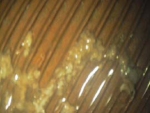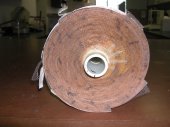Asset protection is a concept that is steadily gaining notoreity in today’s industry. Many plants are looking for ways to optimize their system to get the most they can from their capital equipment, while simultanesouly protecting their equipment and system from a variety of potentially damaging, and costly, variables including water quality, corrosion, and scale.
Looking for the next level of service, plants are in need of a solutions provider that has your best interest in mind with reliable products and programs you can trust. You need a solution that focuses on not only optimization of your water treatment system, but also preventative maintenance to ensure that your system continues running effectively and efficiently for the long term.
WATER QUALITY
Dissolved minerals may affect suitability of water for a range of industrial purposes. The most familiar of these is probably the presence of ions of calcium and magnesium which can form deposits in heating equipment. Hard water can be softened with the use of sodium zeolite water softeners, which substitute calcium and magnesium ions with sodium. This process is ideal when applied to commercial and industrial water softening.
You can optimize your softener with a U.S. Water Brine Elution Study. When a softener with fresh resin is in service, the sodium ions in the surface layer of the bed are immediately exchanged with calcium and magnesium. This will produce soft water with very little residual hardness. The resin bed will continue to exchange its sodium ions with calcium and magnesium ions until the hardness concentration increases rapidly. Referred to as the “breakthrough point”, it is the point at which regeneration is needed.
The following is a typical regeneration sequence:
1) Counterflow backwash and resin. Specified rates based on temperature and manufacturer’s data. Backwashing removes surface deposits and fines, classifies resin and conditions the resin bed for proper regeneration.
2) Regenerate. Brine regeneration consists of educting saturated brine from a brine tank or other source and diluting it to generally 8-10% by weight NaCl. The brine should move through the resin bed, first increasing concentration, the reaching a peak and decreasing until only dilution water is present.
3) Rinse. The fast rinse cycle compacts the resin bed as well as rinsing the final residual brine from it.
Poor regeneration practices are often the cause of problems in zeolite softener systems. An elution study is used to identify and correct softener problems. The study plots the concentration (specific gravity) of brine from a zeolite softener during regeneration along with recording cycle times. The information is then used to troubleshoot and evaluate the system.
CORROSION
[Excerpt from “Rust Isn’t Sleeping” from Chemical Processing magazine.] “Corrosion has plagued process plants since the chemical industry began. After all, many sites handle materials that are inherently corrosive to steel or can become so under conditions that might occur. Acids, bases and salts all can harm hardware and equipment, as, of course, can water. Corrosion causes product contamination, leaks, and equipment malfunctions, which, in turn, can lead to quality, environmental and safety issues. Some major accidents have stemmed from corrosion. Even if a site doesn’t suffer overt mishaps, corrosion shortens the service life of assets. NACE International, formerly the National Association of Corrosion Engineers, (www.nace.org) puts the annual cost of corrosion in the chemical and pharmaceutical manufacturing and petroleum refining at over $5 billion in the U.S. alone.”
“Sometimes, corrosion itself doesn’t create a hazard, but lack of knowledge on the subject matter may get plants into trouble,” as Dirk Willard relates in his Field Notes column “Solve the Real Problem.” He cites a situation in which an engineer decided to replace carbon-steel bolts on a vessel with type 316 stainless steel ones. He didn’t realize this would require de-rating the pressure limit of the vessel by about 15%. If no one else had realized it either, the plant might have put itself at risk. Raising staff skills is important, but so too is an effective corrosion-monitoring program. But reacting to the consequences of corrosion rather than addressing issues before they become problems directly conflicts with the quest of many operating companies to achieve predictive maintenance.” By Mark Rosenzweig, Editor in Chief at Chemical Processing Magazine.
Some techniques to assess corrosion, such as the use of coupons, have proven their effectivenes for decades. Now, in addition, instruments can provide online real-time monitoring of generalized corrosion, i.e., uniform loss of material from a surface, and even localized corrosion such as pitting. Such instruments enable treating corrosion as a process variable that can be related to other variables and specific upset or transient conditions – potentially providing insights that can help avoid or minimize future corrosion. U.S. Water Corrosion Coupon Reports combine detailed pictures of coupons with corrosion coupon analysis using our in-house laboratory to develop a cost-saving and informational service. U.S. Water Corrosion Coupon Service consists of four steps:
1) Consultation to determine correct corrosion coupons
2) Installation by a U.S. Water Representative
3) Removal of corrosion coupons
4) Analysis of corrosion coupons by a U.S. Water Laboratory Technician
A U.S. Water customer had several corrosion coupons installed throughout the six buildings he supervised. He states, “You can’t see if corrosion is happening inside the pipes and equipment. As lead engineer it gives me peace of mind knowing I don’t have to worry about corrosion in the buildings HVAC piping or other equipment.”
SCALE
In many operations, electrical consumption by the chiller can amount to 90% of the overall costs in production this comfort cooling. The implementation of a successful cooling water program can have a major impact on the cost to produce a “ton-hr” of cooling. For example, a very small amount of scale, less than 1/32nd of an inch, or microbiological foulant can reduce efficiency by over 20%.
Consistent monitoring of your cooling tower can greatly improve the performance and alert one to less than optimal conditions. U.S. Water’s TowerAssurance offers complete chemistry monitoring and control, wireless communications, emergency call service and weekly intel reports through U.S. Water’s automated U.S. Water Reports system. The TowerAssurance system monitors inhibitor concentration, pH, conductivity and biocide concentration. Armed with this information, your U.S. Water Representative can provide you with ways to maintain maximum efficiency in your cooling system.
SYSTEM OPTIMIZATION
Annual facility check-ups are an integral part of any plant’s operation. They ensure all resources used at your facility are working together in a manner that is productive for your company. Checking your programs efficiency can help you determine what’s working and what needs to be improved; but understanding how your systems work together and affect efficiency can bring your optimization to a whole new level. U.S. Water’s Plant Efficiency Audits are unique in that we can evaluate your overall system performance for you – understanding the balance between chemical and mechanical water treatment systems and the cause and effect they have on each other.
A majority of plants use a combination of inputs: energy inputs and natural resource inputs, which are interrelated. An example of this would be water and natural gas. If a plant is using too much boiler water through either excessive blowdown or low condensate return, it will consume a higher level of natural gas. This will result in higher operational costs and could be a sign of damaged equipment.
A U.S. Water Services field engineer will audit your plant and determine whether it is operating within the design parameters or at the optimum level. If it is not operating at that level, we will work with you to determine the necessary modifications needed to regain the lost efficiencies. We may also find that the plant is operating per the design specifications, but we may be able to provide ideas that can improve upon the original design.
Plant efficiency audits are highly involved studies of a plant’s utility system. The engineering report will help your company plan for future capital expenditures as well as determine what limitations may face the facility, if expansion is desired. Plant efficiency audits are recommended every two years on a normal operating basis. If expansion projects are being considered, and the last audit is more than a year old, a new audit is recommended.
Contact a U.S. Water Services rep today to find out how you can protect your assets and improve overall plant profitability and equipment optimization.




You must be logged in to post a comment.